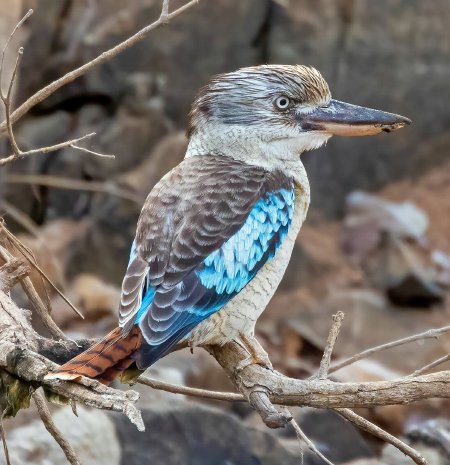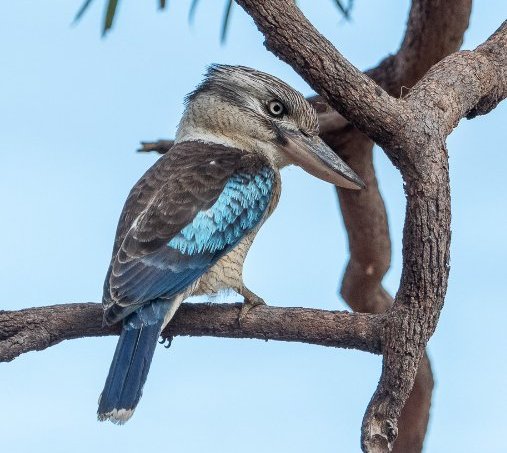The Blue-winged Kookaburra (BWK) (Dacelo leachii) is a very large kingfisher, slightly smaller than its closest relative, the Laughing Kookaburra (LAK) (D. novaeguineae). Unlike the LAK, the BWK is actually found in ‘Novaeguinea’, as well as across the Top End of Australia. Generations of birdwatchers have struggled to like the BWK’s ‘raucous barking’, in contrast to the much-loved LAK ‘laughter’ – regarded as classically Australian. Both calls can be heard in eastern Queensland, where the two species are sympatric from Cape York south to the Gold Coast hinterland.

Their ecology – including diet, breeding, social structure, and defence of perennial all-purpose territories – is very similar. David Curl studied BWK nesting and behaviour in Kakadu National Park, NT, and found two-thirds of BWKs lived in groups, where helpers (subordinate, related non-breeding birds) had similar roles as in LAKs. Competition between sibling chicks in the nest was ruthless (as in LAKs), but more often because larger chicks dominated food supplies, rather than siblicide (see Laughing Kookaburra, Bird of the Month, BQ Newsletter June 2021).

Despite the long term study in the NT savanna, little is known about BWK ecology in the more varied habitats of Queensland, including areas of closer human settlement. Moreover, some aspects of the NT study were never published, even in the extensive HANZAB chapter. The detailed diet and rate of parental provisioning for a brood of BWK nestlings were reported for the first time in Sunbird in 2023. In a single nesting season on Magnetic Island, north Queensland, provisioning by a BWK pair (with no helpers) peaked during Days 17–25, the middle of the nestling period. Of 273 nestling food items, some 75% by estimated volume comprised reptiles – the largest was a snake or legless lizard 90 cm long. Arthropod prey were second by volume, the smallest being a robber fly (25 mm). Three young fledged: the smallest disappeared after a few days, but two remained with the parents for six months and one for at least 10 months.
Over three years the BWK pair consistently defended a 5.5 ha territory, including the nesting tree and other trees with hollows, from intruding LAKs (unpublished data). This interspecific territorial behaviour was first reported in the 1970s. Veronica Parry – who undertook the first systematic study of LAK breeding and behaviour, near Melbourne – visited Magnetic Island and noted (in the Readers Digest Complete Book of Australian Birds) that the two kookaburra species defended territories against each other as if they were conspecifics. Territorial competition between BWKs and LAKs has now been reported from all eastern Queensland regions. However, records are scarce, and it’s possible that in some areas they survive in sympatry through differing habitat preferences rather than territorial defence. This could only be investigated with a systematic study, but e-Birders can contribute useful data by including details of BWK–LAK interactions in their reports.
Further reading:
- Curl, D.A. 2005. The Call of the Kookaburra: The Natural History of the Blue-winged Kookaburra and Other Kingfishers. PhD thesis. Monash University, Clayton, Vic.
- Frith, H.J. (Ed.) 1976. Blue-winged Kookaburra Dacelo leachii. In Complete Book of Australian Birds, p. 320. Readers Digest Services, Sydney, NSW.
- Higgins, P.J. (Ed.) 1999. Handbook of Australian, New Zealand and Antarctic Birds, Vol. 4: Parrots to Dollarbird. Oxford University Press, Melbourne, Vic.
- Legge, S. 2004. Kookaburra: King of the Bush. CSIRO Publishing, Collingwood, Vic.
- Lloyd, P. 2021. Laughing Kookaburra, Dacelo novaeguineae. BQ Newsletter 52(05), June 2021.
- Parry, V.A. 1970. Kookaburras. Lansdowne Press, Melbourne, Vic.
- Scambler, E.C. & Daly, P.J. 2023. Breeding behaviour and nestling diet of Blue-winged Kookaburras Dacelo leachii on Magnetic Island, North Queensland. Sunbird 50: 24-37.


